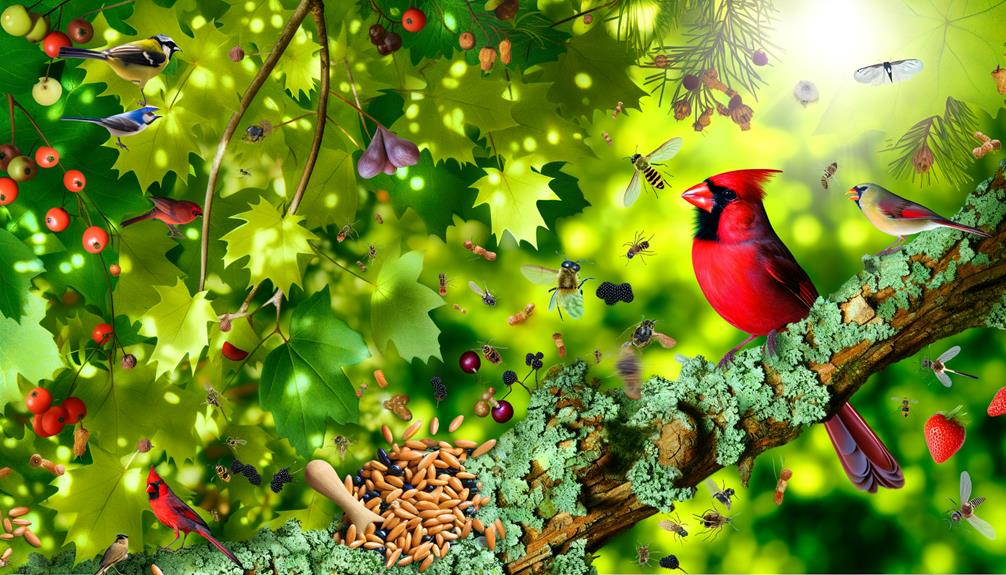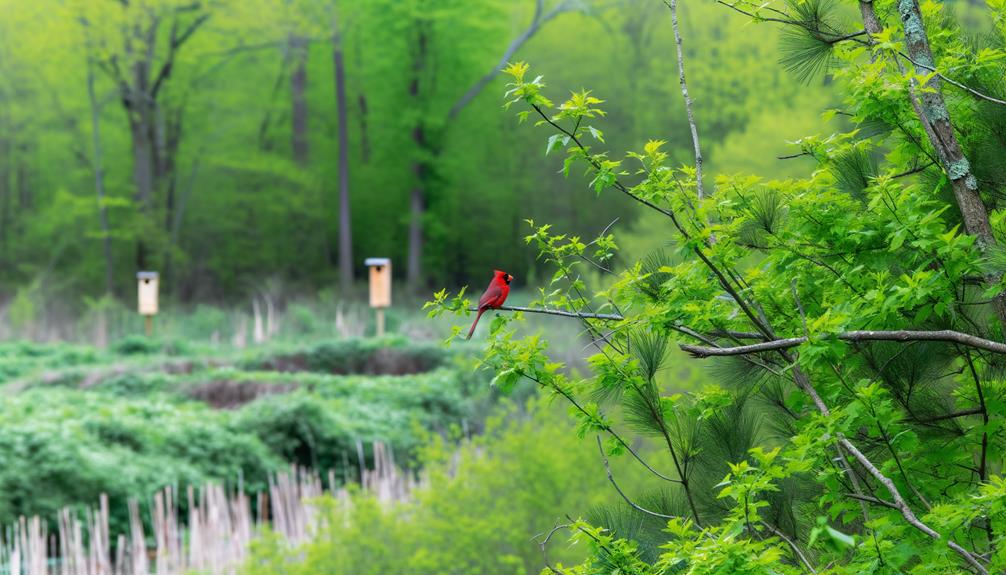Fascinating Facts: The Northern Cardinal
The Northern Cardinal showcases sexually dimorphic plumage, where males display vibrant red feathers and females sport tan hues. They inhabit diverse environments across North and Central America, preferring forest edges and suburban areas.
Their diet includes seeds, berries, and insects, with a strong preference for sunflower seeds. Monogamous pairs breed from March to September, nesting in dense shrubs or low trees.
Males are known for their rich, melodious songs, essential for territorial defense and mate attraction. Each male can produce up to 12 distinct song types.
Explore their enchanting behaviors and strong site fidelity for more fascinating insights.

Key Takeaways
- Male Northern Cardinals are bright red, while females have tan plumage.
- Cardinals primarily eat seeds, fruits, and insects, favoring sunflower seeds.
- They thrive in diverse habitats, including suburban and urban areas.
- Cardinals are monogamous, with breeding season from March to September.
- Male cardinals sing melodious songs to establish territory and attract mates.
Appearance and Plumage

The Northern Cardinal, scientifically known as Cardinalis cardinalis, exhibits sexually dimorphic plumage, with males boasting vibrant red feathers and females displaying more subdued, tan hues with reddish accents. Males' striking red coloration serves as a visual signal during mating displays and territorial defense, facilitated by carotenoid pigments derived from their diet.
Females, with their cryptic coloration, benefit from enhanced camouflage, particularly during nesting. Both sexes feature a distinctive black facial mask, prominent crest, and stout, conical beak adapted for seed consumption.
Juveniles resemble females but possess a duller, brownish plumage. Molting occurs annually, allowing for feather renewal and maintenance of their striking appearance. This species' plumage serves critical roles in communication, reproduction, and survival.
Habitat and Range
Beyond their striking appearance, Northern Cardinals thrive in diverse habitats ranging from woodlands and gardens to wetlands and shrublands across North and Central America. They exhibit remarkable adaptability, inhabiting areas with dense foliage and abundant food sources.
Their range extends from southern Canada to northern Argentina, encompassing varied climates and altitudes. These birds prefer edge habitats where forest meets open spaces, benefiting from the mix of cover and foraging opportunities. Suburban and urban environments also support their populations, provided there's sufficient vegetation.
Cardinals demonstrate strong site fidelity, often returning to the same breeding and wintering grounds annually. Their ability to exploit a wide range of ecological niches underscores their success as one of the most widespread songbird species.
Diet and Feeding Habits

Northern Cardinals primarily consume seeds, fruits, and insects, showcasing a diverse diet that supports their nutritional needs throughout the year. These birds exhibit a preference for specific food types, guaranteeing they can sustain themselves in various environments. They frequently forage on the ground or in low shrubs, meticulously searching for food.
Seeds:
Sunflower seeds are particularly favored, providing essential fats and proteins.
Fruits:
They consume berries like dogwood, mulberry, and wild grape.
Insects:
Grasshoppers, beetles, and caterpillars offer crucial protein.
Grains:
Small grains such as millet and corn are also part of their diet.
Tree buds:
In early spring, they eat buds from trees and shrubs to supplement their diet.
This opportunistic feeding behavior guarantees their survival across seasons.
Breeding and Nesting
Cardinals display monogamous breeding behavior, often forming long-term pair bonds that contribute to their reproductive success. They typically breed from March to September, constructing nests in dense shrubs or low tree branches. Females primarily build the nests using twigs, bark strips, and grasses, while males assist by gathering materials.
Once the nest is complete, the female lays three to four eggs, incubating them for about 12-13 days. Both parents share the responsibility of feeding the nestlings, who fledge approximately 9-11 days after hatching.
| Stage | Duration (Days) | Primary Caregiver |
|---|---|---|
| Egg Laying | 1-3 | Female |
| Incubation | 12-13 | Female |
| Nestling | 9-11 | Both Parents |
| Fledging | Immediate | Both Parents |
These cooperative behaviors guarantee high offspring survival rates.
Vocalizations and Songs

Male cardinals are renowned for their rich, melodious songs, which they use to establish territories and attract mates. Their vocalizations can be complex, featuring a variety of notes and phrases. These songs aren't only beautiful but serve vital functions in the cardinal's life cycle. Males and females both sing, a unique trait among North American songbirds.
- Frequency Range: Cardinal songs typically range between 2 and 10 kHz.
- Song Repertoire: Each male can produce up to 12 distinct song types.
- Duetting: Pairs often engage in coordinated singing or duetting.
- Learning: Juvenile cardinals learn their songs from adult tutors, usually their parents.
- Alarm Calls: They use sharp, metallic 'chip' sounds to signal danger.
Understanding these vocalizations provides insight into their ecological roles and behavioral ecology.
Behavior and Social Structure
While their songs play a critical role in communication, observing cardinal behavior reveals a complex social structure characterized by monogamous pair bonds and territoriality. Pairs often remain together year-round, maintaining strong bonds through mutual feeding and close proximity.
During the breeding season, males exhibit marked territorial aggression, engaging in visual displays like crest raising and wing flicking to ward off intruders. These behaviors secure exclusive access to resources. Females contribute by selecting nest sites and constructing nests, indicating a division of labor.
Juveniles, once fledged, form loose flocks before establishing their territories. This social structure underscores the cardinal's adaptive strategies for survival and reproduction, emphasizing cooperation and individual roles within their habitat.
Conservation Status

Despite facing various environmental challenges, the Northern Cardinal's conservation status remains safeguarded, thanks to its adaptability and widespread habitat range. This species, classified as Least Concern by the IUCN, thrives in diverse environments, from woodlands to urban gardens. Its ability to adjust to varying food sources and nesting conditions further fortifies its resilience.
Key factors contributing to its stable population include:
- Dietary flexibility: Consumes seeds, fruits, and insects.
- Habitat versatility: Found in forests, swamps, and suburban areas.
- Breeding success: High reproductive rate with multiple broods per year.
- Human interaction: Benefits from bird feeders and ornamental plantings.
- Climate tolerance: Adapts to a range of temperatures and weather conditions.
These attributes guarantee the Northern Cardinal's continued ecological presence.
Conclusion
Despite its striking red plumage and enchanting songs, the Northern Cardinal isn't just a pretty face.
Ironically, while humans romanticize its vibrant appearance and melodic calls, the cardinal's primary concern remains survival—finding food, securing territory, and reproducing.
This bird's resilience and adaptability underscore its success across diverse habitats.
So, while we might admire its beauty, the cardinal continues its daily routines, oblivious to the adoration it garners from its human admirers.






